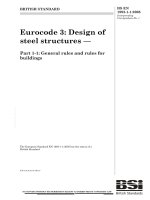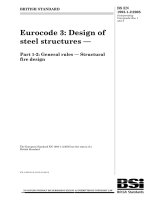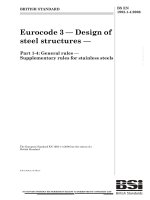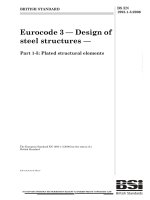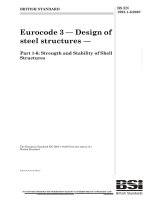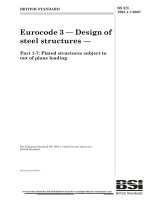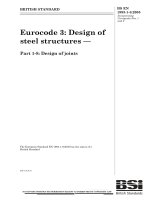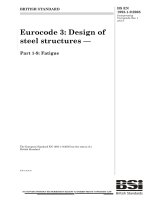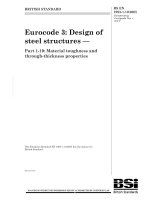Tiêu chuẩn Châu Âu EC3: Kết cấu thép phần 4.1: Bể chứa (Eurocode3 BS EN1993 4 1 e 2007 Design of steel structures part 4.1: Sillo)
Bạn đang xem bản rút gọn của tài liệu. Xem và tải ngay bản đầy đủ của tài liệu tại đây (942.79 KB, 118 trang )
BRITISH STANDARD
Eurocode 3 — Design of
steel structures —
--`,,`,`,``,,,,`,`,```,```,```-`-`,,`,,`,`,,`---
Part 4-1: Silos
The European Standard EN 1993-4-1:2007 has the status of a
British Standard
ICS 65.040.20; 91.010.30; 91.080.10
12 &23<,1* :,7+287 %6, 3(50,66,21 (;&(37 $6 3(50,77(' %< &23<5,*+7 /$:
BS EN
1993-4-1:2007
BS EN 1993-4-1:2007
--`,,`,`,``,,,,`,`,```,```,```-`-`,,`,,`,`,,`---
National foreword
This British Standard was published by BSI. It is the UK implementation of
EN 1993-4-1:2007.
The UK participation in its preparation was entrusted by Technical Committee
B/525, Building and civil engineering structures, to Subcommittee B/525/31,
Structural use of steel.
A list of organizations represented on this committee can be obtained on
request to its secretary.
This publication does not purport to include all the necessary provisions of a
contract. Users are responsible for its correct application.
Compliance with a British Standard cannot confer immunity from
legal obligations.
This British Standard was
published under the authority
of the Standards Policy and
Strategy Committee
on 31 May 2007
© BSI 2007
ISBN 978 0 580 50673 4
Amendments issued since publication
Amd. No.
Date
Comments
EUROPEAN STANDARD
EN 1993-4-1
NORME EUROPÉENNE
EUROPÄISCHE NORM
February 2007
ICS 65.040.20; 91.010.30; 91.080.10
Supersedes ENV 1993-4-1:1999
English Version
Eurocode 3 - Design of steel structures - Part 4-1: Silos
Eurocode 3 - Calcul des structures en acier - Partie 4-1:
Silos
Eurocode 3 - Bemessung und Konstruktion von
Stahlbauten - Teil 4-1: Silos
This European Standard was approved by CEN on 12 June 2006.
CEN members are bound to comply with the CEN/CENELEC Internal Regulations which stipulate the conditions for giving this European
Standard the status of a national standard without any alteration. Up-to-date lists and bibliographical references concerning such national
standards may be obtained on application to the CEN Management Centre or to any CEN member.
This European Standard exists in three official versions (English, French, German). A version in any other language made by translation
under the responsibility of a CEN member into its own language and notified to the CEN Management Centre has the same status as the
official versions.
CEN members are the national standards bodies of Austria, Belgium, Bulgaria, Cyprus, Czech Republic, Denmark, Estonia, Finland,
France, Germany, Greece, Hungary, Iceland, Ireland, Italy, Latvia, Lithuania, Luxembourg, Malta, Netherlands, Norway, Poland, Portugal,
Romania, Slovakia, Slovenia, Spain, Sweden, Switzerland and United Kingdom.
EUROPEAN COMMITTEE FOR STANDARDIZATION
COMITÉ EUROPÉEN DE NORMALISATION
EUROPÄISCHES KOMITEE FÜR NORMUNG
Management Centre: rue de Stassart, 36
© 2007 CEN
All rights of exploitation in any form and by any means reserved
worldwide for CEN national Members.
--`,,`,`,``,,,,`,`,```,```,```-`-`,,`,,`,`,,`---
B-1050 Brussels
Ref. No. EN 1993-4-1:2007: E
EN 1993-4-1: 2007 (E)
Contents
Foreword
4
1
General
1.1 Scope
1.2 Normative references
1.3 Assumptions
1.4 Distinction between principles and application rules
1.5 Terms and definitions
1.6 Symbols used in Part 4.1 of Eurocode 3
1.7 Sign conventions
1.8 Units
9
9
9
10
10
10
13
15
20
2
Basis of design
2.1 Requirements
2.2 Reliability differentiation
2.3 Limit states
2.4 Actions and environmental effects
2.5 Material properties
2.6 Geometrical data
2.7 Modelling of the silo for determining action effects
2.8 Design assisted by testing
2.9 Action effects for limit state verifications
2.10 Durability
2.11 Fire resistance
20
20
20
21
22
22
22
22
22
23
24
24
3
Properties of materials
3.1 General
3.2 Structural steels
3.3 Stainless steels
3.4 Special alloy steels
3.5 Toughness requirements
25
25
25
25
25
26
4
Basis for structural analysis
4.1 Ultimate limit states
4.2 Analysis of the structure of a shell silo
4.3 Analysis of the box structure of a rectangular silo
4.4 Equivalent orthotropic properties of corrugated sheeting
27
27
28
31
32
5
Design of cylindrical walls
5.1 Basis
5.2 Distinctions between cylindrical shell forms
5.3 Resistance of silo cylindrical walls
5.4 Special support conditions for cylindrical walls
5.5 Detailing for openings in cylindrical walls
5.6 Serviceability limit states
35
35
35
36
59
64
65
6
Design of conical hoppers
6.1 Basis
6.2 Distinctions between hopper shell forms
6.3 Resistance of conical hoppers
6.4 Considerations for special hopper structures
6.5 Serviceability limit states
66
66
66
67
72
73
2
--`,,`,`,``,,,,`,`,```,```,```-`-`,,`,,`,`,,`---
EN 1993-4-1: 2007 (E)
7
Design of circular conical roof structures
7.1 Basis
7.2 Distinctions between roof structural forms
7.3 Resistance of circular conical silo roofs
75
75
75
75
8
Design of transition junctions and supporting ring girders
8.1 Basis
8.2 Analysis of the junction
8.3 Structural resistances
8.4 Limit state verifications
8.5 Considerations concerning support arrangements for the junction
77
77
80
86
90
92
9
Design of rectangular and planar-sided silos
9.1 Basis
9.2 Classification of structural forms
9.3 Resistance of unstiffened vertical walls
9.4 Resistance of silo walls composed of stiffened and corrugated plates
9.5 Silos with internal ties
9.6 Strength of pyramidal hoppers
9.7 Vertical stiffeners on box walls
9.8 Serviceability limit states
94
94
94
95
95
100
100
102
102
Annex A: [Informative]
104
Simplified rules for circular silos in Consequence Class 1
A.1 Action combinations for Consequence Class 1
A.2 Action effect assessment
A.3 Ultimate limit state assessment
104
104
104
104
Annex B: [Informative]
111
Expressions for membrane stresses in conical hoppers
111
Annex C: [Informative]
113
Distribution of wind pressure around circular silo structures
113
--`,,`,`,``,,,,`,`,```,```,```-`-`,,`,,`,`,,`---
3
EN 1993-4-1: 2007 (E)
Foreword
This European Standard shall be given the status of a National Standard, either by publication of an
identical text or by endorsement, at the latest by August 2007 and conflicting National Standards shall be
withdrawn at latest by March 2010.
This Eurocode supersedes ENV 1993-4-1:1999.
--`,,`,`,``,,,,`,`,```,```,```-`-`,,`,,`,`,,`---
This European Standard EN 1993-4-1, “Eurocode 3: Design of steel structures – Part 4-1: Silos”, has
been prepared by Technical Committee CEN/TC250 « Structural Eurocodes », the Secretariat of
which is held by BSI. CEN/TC250 is responsible for all Structural Eurocodes.
According to the CEN-CENELEC Internal Regulations, the National Standard Organizations of the
following countries are bound to implement this European Standard: Austria, Belgium, Bulgaria, Cyprus, Czech
Republic, Denmark, Estonia, Finland, France, Germany, Greece, Hungary, Iceland, Ireland, Italy,
Latvia, Lithuania, Luxembourg, Malta, Netherlands, Norway, Poland, Portugal, Romania, Slovakia,
Slovenia, Spain, Sweden, Switzerland and United Kingdom.
Background of the Eurocode programme
In 1975, the Commission of the European Community decided on an action programme in the field of
construction, based on article 95 of the Treaty. The objective of the programme was the elimination of
technical obstacles to trade and the harmonisation of technical specifications.
Within this action programme, the Commission took the initiative to establish a set of harmonised
technical rules for the design of construction works which, in a first stage, would serve as an
alternative to the national rules in force in the Member States and, ultimately, would replace them.
For fifteen years, the Commission, with the help of a Steering Committee with Representatives of
Member States, conducted the development of the Eurocodes programme, which led to the first
generation of European codes in the 1980’s.
In 1989, the Commission and the Member States of the EU and EFTA decided, on the basis of an
agreement1) between the Commission and CEN, to transfer the preparation and the publication of the
Eurocodes to the CEN through a series of Mandates, in order to provide them with a future status of
European Standard (EN). This links de facto the Eurocodes with the provisions of all the Council’s
Directives and/or Commission’s Decisions dealing with European standards (e.g. the Council
Directive 89/106/EEC on construction products - CPD - and Council Directives 93/37/EEC,
92/50/EEC and 89/440/EEC on public works and services and equivalent EFTA Directives initiated in
pursuit of setting up the internal market).
The Structural Eurocode programme comprises the following standards generally consisting of a
number of Parts:
EN1990
EN1991
EN1992
EN1993
EN1994
EN1995
1)
Eurocode: Basis of structural design
Eurocode 1: Actions on structures
Eurocode 2: Design of concrete structures
Eurocode 3: Design of steel structures
Eurocode 4: Design of composite steel and concrete structures
Eurocode 5: Design of timber structures
Agreement between the Commission of the European Communities and the European Committee for
Standardisation (CEN) concerning the work on EUROCODES for the design of building and civil engineering
works (BC/CEN/03/89).
4
EN 1993-4-1: 2007 (E)
EN1996
EN1997
EN1998
EN1999
Eurocode 6: Design of masonry structures
Eurocode 7: Geotechnical design
Eurocode 8: Design of structures for earthquake resistance
Eurocode 9: Design of aluminium structures
Eurocode standards recognise the responsibility of regulatory authorities in each Member State and
have safeguarded their right to determine values related to regulatory safety matters at national level
where these continue to vary from State to State.
Status and field of application of Eurocodes
The Member States of the EU and EFTA recognise that EUROCODES serve as reference documents
for the following purposes:
--`,,`,`,``,,,,`,`,```,```,```-`-`,,`,,`,`,,`---
−
as a means to prove compliance of building and civil engineering works with the essential
requirements of Council Directive 89/106/EEC, particularly Essential Requirement N°1 Mechanical resistance and stability - and Essential Requirement N°2 - Safety in case of fire ;
−
as a basis for specifying contracts for construction works and related engineering services ;
−
as a framework for drawing up harmonised technical specifications for construction products
(ENs and ETAs)
The Eurocodes, as far as they concern the construction works themselves, have a direct relationship
with the Interpretative Documents2) referred to in Article 12 of the CPD, although they are of a
different nature from harmonised product standards3). Therefore, technical aspects arising from the
Eurocodes work need to be adequately considered by CEN Technical Committees and/or EOTA
Working Groups working on product standards with a view to achieving full compatibility of these
technical specifications with the Eurocodes.
The Eurocode standards provide common structural design rules for everyday use for the design of
whole structures and component products of both a traditional and an innovative nature. Unusual
forms of construction or design conditions are not specifically covered and additional expert
consideration will be required by the designer in such cases.
National Standards implementing Eurocodes
The National Standards implementing Eurocodes will comprise the full text of the Eurocode
(including any annexes), as published by CEN, which may be preceded by a National title page and
National foreword, and may be followed by a National Annex.
The National Annex may only contain information on those parameters which are left open in the
Eurocode for national choice, known as Nationally Determined Parameters, to be used for the design
of buildings and civil engineering works to be constructed in the country concerned, i.e. :
2)
According to Art. 3.3 of the CPD, the essential requirements (ERs) shall be given concrete form in
interpretative documents for the creation of the necessary links between the essential requirements and the
mandates for harmonised ENs and ETAGs/ETAs.
3)
According to Art. 12 of the CPD the interpretative documents shall :
a) give concrete form to the essential requirements by harmonising the terminology and the technical bases
and indicating classes or levels for each requirement where necessary ;
b) indicate methods of correlating these classes or levels of requirement with the technical specifications, e.g.
methods of calculation and of proof, technical rules for project design, etc. ;
c) serve as a reference for the establishment of harmonised standards and guidelines for European technical
approvals.
The Eurocodes, de facto, play a similar role in the field of the ER 1 and a part of ER 2.
5
−
values and/or classes where alternatives are given in the Eurocode,
−
values to be used where a symbol only is given in the Eurocode,
−
country specific data (geographical, climatic, etc), e.g. snow map,
−
the procedure to be used where alternative procedures are given in the Eurocode.
It may also contain:
− decisions on the application of informative annexes,
−
references to non-contradictory complementary information to assist the user to apply the
Eurocode.
Links between Eurocodes and harmonised technical specifications (ENs and ETAs) for products
There is a need for consistency between the harmonised technical specifications for construction
products and the technical rules for works4). Furthermore, all the information accompanying the CE
Marking of the construction products which refer to Eurocodes should clearly mention which
Nationally Determined Parameters have been taken into account.
Additional information specific to EN1993-4-1
EN 1993-4-1 gives design guidance for the structural design of silos.
EN 1993-4-1 gives design rules that supplement the generic rules in the many parts of EN 1993-1.
EN 1993-4-1 is intended for clients, designers, contractors and relevant authorities.
EN 1993-4-1 is intended to be used in conjunction with EN 1990, with EN 1991-4, with the other
Parts of EN 1991, with EN 1993-1-6 and EN 1993-4-2, with the other Parts of EN 1993, with
EN 1992 and with the other Parts of EN 1994 to EN 1999 relevant to the design of silos. Matters that
are already covered in those documents are not repeated.
Numerical values for partial factors and other reliability parameters are recommended as basic values
that provide an acceptable level of reliability. They have been selected assuming that an appropriate
level of workmanship and quality management applies.
Safety factors for ‘product type’ silos (factory production) can be specified by the appropriate
authorities. When applied to ‘product type’ silos, the factors in 2.10 are for guidance purposes only.
They are provided to show the likely levels needed to achieve consistent reliability with other designs.
National Annex for EN1993-4-1
This standard gives alternative procedures, values and recommendations for classes with notes
indicating where national choices may have to be made. Therefore the National Standard
implementing EN 1993-4-1 should have a National Annex containing all Nationally Determined
Parameters to be used for the design of buildings and civil engineering works to be constructed in the
relevant country.
National choice is allowed in EN 1993-4-1 through:
−
2.2 (1)
−
2.2 (3)
4)
see Art.3.3 and Art.12 of the CPD, as well as clauses 4.2, 4.3.1, 4.3.2 and 5.2 of ID 1.
6
--`,,`,`,``,,,,`,`,```,```,```-`-`,,`,,`,`,,`---
EN 1993-4-1: 2007 (E)
EN 1993-4-1: 2007 (E)
−
2.9.2.2 (3)
−
3.4 (1)
−
4.1.4 (2) and (4)
−
4.2.2.3 (6)
−
4.3.1 (6) and (8)
−
5.3.2.3 (3)
−
5.3.2.4 (10), (12) and (15)
−
5.3.2.5 (10) and (14)
−
5.3.2.6 (3) and (6)
−
5.3.2.8 (2)
−
5.3.3.5 (1) and (2)
−
5.3.4.3.2 (2)
−
5.3.4.3.3 (2) and (5)
−
5.3.4.3.4 (5)
−
5.3.4.5 (3)
−
5.4.4 (2), (3) and (4)
−
5.4.7 (3)
−
5.5.2 (3)
−
5.6.2 (1) and (2)
−
6.1.2 (4)
−
6.3.2.3 (2) and (4)
−
6.3.2.7 (3)
−
7.3.1 (4)
−
8.3.3 (4)
−
8.4.1 (6)
−
8.4.2 (5)
−
8.5.3 (3)
−
9.5.1 (3) and (4)
−
9.5.2 (5)
−
9.8.2 (1) and (2)
−
A.2 (1) and (2)
−
A.3.2.1 (6)
−
A.3.2.2 (6)
−
A.3.2.3 (2)
−
A.3.3 (1), (2) and (3)
−
A.3.4 (4)
--`,,`,`,``,,,,`,`,```,```,```-`-`,,`,,`,`,,`---
7
EN 1993-4-1: 2007 (E)
1
General
1.1 Scope
(1) Part 4.1 of Eurocode 3 provides principles and application rules for the structural design of steel
silos of circular or rectangular plan-form, being free standing or supported.
(2) The provisions given in this Part supplement modify or supersede the equivalent provisions
given in EN 1993-1.
(3) This part is concerned only with the requirements for resistance and stability of steel silos. For
other requirements (such as operational safety, functional performance, fabrication and erection,
quality control, details like man-holes, flanges, filling devices, outlet gates and feeders etc.), see the
relevant standards.
(4) Provisions relating to special requirements of seismic design are provided in EN 1998-4, which
complements or adapts the provisions of Eurocode 3 specifically for this purpose.
(5) The design of supporting structures for the silo are dealt with in EN 1993-1-1. The supporting
structure is deemed to consist of all structural elements beneath the bottom flange of the lowest ring of
the silo, see figure 1.1.
(6)
Foundations in reinforced concrete for steel silos are dealt with in EN 1992 and EN 1997.
(7) Numerical values of the specific actions on steel silos to be taken into account in the design are
given in EN 1991-4 Actions in Silos and Tanks.
(8)
−
−
−
−
This Part 4.1 does not cover:
resistance to fire;
silos with internal subdivisions and internal structures;
silos with capacity less than 10 tonnes;
cases where special measures are necessary to limit the consequences of accidents.
(9) Where this standard applies to circular planform silos, the geometric form is restricted to
axisymmetric structures, but the actions on them may be unsymmetrical, and their supports may
induce forces in the silo that are not axisymmetrical.
1.2 Normative references
--`,,`,`,``,,,,`,`,```,```,```-`-`,,`,,`,`,,`---
This European Standard incorporates, by dated and undated reference, provisions from other
standards. These normative references are cited at the appropriate places in the text and the
publications are listed hereafter. For dated references, subsequent amendments to, or revisions of, any
of these publications apply to the European Standard only when incorporated in it by amendment or
revision. For undated references the latest edition of the publication referred to applies.
EN 1090
Execution of steel structures;
EN 1990
Eurocode: Basis of design;
EN 1991
Eurocode 1: Actions on structures;
8
Part 1.1
Actions on structures – Densities, self-weight and imposed loads for buildings;
Part 1.2:
Actions on structures – Actions on structures exposed to fire;
Part 1.3:
Actions on structures – Snow loads;
Part 1.4:
Actions on structures – Wind loads;
EN 1993-4-1: 2007 (E)
Part 1.5:
Actions on structures – Thermal loads;
Part 1.6:
Actions on structures – Construction loads;
Part 1.5:
Actions on structures – Accidental actions;
Part 4:
Actions on silos and tanks;
Eurocode 3: Design of steel structures;
Part 1.1:
General rules and rules for buildings;
Part 1.3:
Cold formed thin gauge members and sheeting;
Part 1.4:
Stainless steels;
Part 1.6:
Strength and stability of shell structures;
Part 1.7:
Planar plated structures loaded transversely;
Part 1.8:
Design of joints;
Part 1.9:
Fatigue strength of steel structures;
Part 1.10:
Selection of steel for fracture toughness and through-thickness properties;
Part 4.2:
Tanks;
EN 1997
Eurocode 7: Geotechnical design;
EN 1998
Eurocode 8: Design provisions for earthquake resistance of structures;
Part 4:
--`,,`,`,``,,,,`,`,```,```,```-`-`,,`,,`,`,,`---
EN 1993
Silos, tanks and pipelines;
EN 10025
Hot rolled products of non-alloy structural steels - technical delivery
conditions;
EN 10147
Hot-rolled flat products made of high yield strength steels for cold forming;
ISO 1000
SI Units;
ISO 3898
Bases for design of structures - Notation - General symbols;
ISO 4997
Cold reduced steel sheet of structural quality;
ISO 8930
General principles on reliability for structures - List of equivalent terms.
1.3 Assumptions
(1)
In addition to the general assumptions of EN 1990 the following assumptions apply:
– fabrication and erection complies with EN 1090-2
1.4 Distinction between principles and application rules
(1)
See 1.4 in EN 1990.
1.5 Terms and definitions
(1) The terms that are defined in 1.5 in EN 1990 for common use in the Structural Eurocodes and
the definitions given in ISO 8930 apply to this Part 4.1 of EN 1993, unless otherwise stated, but for
the purposes of this Part 4.1 the following supplementary definitions are given:
1.5.1 shell. A structure formed from a curved thin plate.
9
EN 1993-4-1: 2007 (E)
1.5.2 axisymmetric shell. A shell structure whose geometry is defined by rotation of a meridional
line about a central axis.
1.5.3 box. A structure formed from an assembly of flat plates into a three-dimensional enclosed
form. For the purposes of this Standard, the box has dimensions that are generally comparable in all
directions.
1.5.4 meridional direction. The tangent to the silo wall in a vertical plane at any point. It varies
according to the structural element being considered. Alternatively, it is the vertical or inclined
direction on the surface of the structure that a rain drop would take in sliding down the surface.
1.5.5 circumferential direction. The horizontal tangent to the silo wall at any point. It varies
around the silo, lies in the horizontal plane and is tangential to the silo wall irrespective of whether the
silo is circular or rectangular in plan.
1.5.6 middle surface. This term is used to refer to both the stress-free middle surface when a shell is
in pure bending and the middle plane of a flat plate that forms part of a box.
1.5.7 separation of stiffeners. The centre to centre distance between the longitudinal axes of two
adjacent parallel stiffeners.
--`,,`,`,``,,,,`,`,```,```,```-`-`,,`,,`,`,,`---
Supplementary to Part 1 of EN 1993 (and Part 4 of EN 1991), for the purposes of this Part 4.1, the
following terminology applies, see figure 1.1:
1.5.8 silo: A silo is a vessel for storing particulate granular solids. In this Standard, it is assumed to
have a vertical form with solids being added by gravity at the top. The term silo includes all forms of
particulate solids storage structure, that might otherwise be referred to as a bin, hopper, grain tank or
bunker.
1.5.9 barrel: The barrel is the vertical walled section of a silo.
1.5.10 hopper: A hopper is a converging section towards the bottom of a silo. It is used to channel
solids towards a gravity discharge outlet.
1.5.11 junction: A junction is the point at which any two or more shell segments, or two or more flat
plate elements of a box meet. It can include a stiffener or not: the point of attachment of a ring
stiffener to the shell or box may be treated as a junction.
1.5.12 transition junction: The transition junction is the junction between the barrel and hopper.
The junction can be at the base of the barrel or part way down it.
1.5.13 skirt: The skirt is that part of the barrel which lies below the transition junction: it differs
from the higher part in that it has no contact with the stored bulk solids.
1.5.14 strake: A strake or course is a single layer of steel plates used to form one level of the
cylindrical barrel of a silo.
1.5.15 stringer stiffener: A stringer stiffener is a local stiffening member that follows the meridian
of a shell, representing a generator of the shell of revolution. It is provided to increase the stability, or
to assist with the introduction of local loads or to carry axial loads. It is not intended to provide a
primary load carrying capacity for bending due to transverse loads.
1.5.16 rib: A rib is a local member that provides a primary load carrying path for loads causing
bending down the meridian of a shell or flat plate, representing a generator of the shell of revolution
10
EN 1993-4-1: 2007 (E)
or a vertical stiffener on a box. It is used to distribute transverse loads on the structure by bending
action.
1.5.17 ring stiffener: A ring stiffener is a local stiffening member that passes around the
circumference of the structure at a given point on the meridian. It is assumed to have no stiffness in
the meridional plane of the structure. It is provided to increase the stability or to introduce local
loads, not as a primary load-carrying element. In a shell of revolution it is circular, but in rectangular
structures is takes the rectangular form of the plan section.
1.5.18 smeared stiffeners: Stiffeners are said to be smeared when the properties of the shell wall
and the individual stiffeners are treated as a composite section using a width equal to an integer
multiple of the separation of the stiffeners. The stiffness properties of a shell wall with smeared
stiffeners are orthotropic with eccentric terms leading to coupling between bending and stretching
behaviour.
Pyramidal
roof
Conical roof
Cylindrical
shell or
barrel
Ring
Transition
Rectangular
box
Transition
Skirt
Silo
ends
here
Skirt
Pyramidal hopper
Conical hopper
Column:
supporting
structure
a) Circular planform silo
Ring girder
Column:
supporting
structure
b) Rectangular planform silo
Figure 1.1: Terminology used in silo structures
1.5.19 base ring: A base ring is a structural member that passes around the circumference of the
structure at the base and provides means of attachment of the structure to a foundation or other
element. It is required to ensure that the assumed boundary conditions are achieved in practice.
1.5.20 ring girder or ring beam: A ring girder or ring beam is a circumferential stiffener which has
bending stiffness and strength both in the plane of the circular section of a shell or the plan section of
a rectangular structure and also normal to that plane. It is a primary load-carrying element, used to
distribute local loads into the shell or box structure.
1.5.21 continuous support: A continuously supported silo is one in which all positions around the
circumference are supported in an identical manner. Minor departures from this condition (e.g. a
small opening) need not affect the applicability of the definition.
1.5.22 discrete support: A discrete support is a position in which a silo is supported using a local
bracket or column, giving a limited number of narrow supports around the silo circumference. Four or
six discrete supports are commonly used, but three or more than six are also found.
--`,,`,`,``,,,,`,`,```,```,```-`-`,,`,,`,`,,`---
11
EN 1993-4-1: 2007 (E)
1.5.23 pyramidal hopper: A pyramidal hopper is used for the hopper section of a rectangular silo,
in the form of an inverted pyramid. In this Standard, it is assumed that the geometry is simple,
consisting of only four planar elements of trapezoidal shape.
1.6 Symbols used in Part 4.1 of Eurocode 3
The symbols used are based on ISO 3898: 1987.
1.6.1
Roman upper case letters
A
C
C
D
E
F
G
H
I
It
K
L
M
N
Q
Rφ
1.6.2
area of cross-section;
membrane stretching stiffness;
buckling coefficient;
bending flexural rigidity;
Young’s modulus;
force;
shear modulus;
height of structure;
second moment of area of cross-section;
uniform torsion constant;
flexural stiffness of wall panel;
height of shell segment or stiffener;
bending moment;
axial force;
fabrication tolerance quality of construction of a shell susceptible to buckling;
local radius at the crest or trough of a corrugation.
Roman lower case letters
a
b
d
e
fy
fu
h
j
j
l
l
l
m
mx
my
mθ
mxy
mxθ
n
n
nx
ny
nθ
nxy
nxθ
12
coefficient;
width of plate or stiffener;
crest to crest dimension of a corrugation;
eccentricity of force or stiffener;
yield strength of steel;
ultimate strength of steel;
separation of flanges of ring girder;
joint efficiency factor for welded lap joints assessed using membrane stresses;
equivalent harmonic of the design stress variation;
effective length of shell in linear stress analysis;
wavelength of a corrugation in corrugated sheeting;
half wavelength of a potential buckle (height to be considered in calculation);
bending moment per unit width;
meridional bending moment per unit circumference;
circumferential bending moment per unit height of box;
circumferential bending moment per unit height of shell;
twisting shear moment per unit width of plate;
twisting shear moment per unit width of shell;
membrane stress resultant;
number of discrete supports around silo circumference;
meridional membrane stress resultant per unit circumference;
circumferential membrane stress resultant per unit height of box;
circumferential membrane stress resultant per unit height of shell;
membrane shear stress resultant per unit width of plate;
membrane shear stress resultant per unit width of shell;
--`,,`,`,``,,,,`,`,```,```,```-`-`,,`,,`,`,,`---
EN 1993-4-1: 2007 (E)
p
pn
px
pθ
q
r
r
s
t
tx, ty
w
w
x
y
z
z
1.6.3
pressure distributed loading;
pressure normal to shell (outward);
meridional surface loading parallel to shell (downward);
circumferential surface loading parallel to shell (anticlockwise in plan);
transverse force per unit length acting on a tie;
radial coordinate in a circular plan-form silo;
radius of shell middle surface;
circumferential separation of stiffeners;
wall thickness;
equivalent wall thickness of corrugated sheet for stretching in the x, y directions;
imperfection amplitude;
radial deflection;
local meridional coordinate;
local circumferential coordinate;
global axial coordinate;
coordinate along the vertical axis of an axisymmetric silo (shell of revolution).
Greek letters
α
α
β
γF
γM
δ
∆
χ
χ
λ
−
λ
µ
ν
θ
σ
σbx
σby
σbθ
τbxy
τbxθ
σmx
σmy
σmθ
τmxy
τmxθ
σsox
σsoy
σsoθ
τsoxy
τsoxθ
τ
ω
elastic buckling imperfection factor (knock-down factor);
coefficient of thermal expansion;
hopper apex half angle;
partial factor for actions;
partial factor for resistance;
limiting deflection;
increment;
reduction factor for flexural column buckling;
shell buckling stress reduction factor;
shell meridional bending half-wavelength;
relative slenderness of a shell;
wall friction coefficient;
Poisson’s ratio;
circumferential coordinate around shell;
direct stress;
meridional bending stress;
circumferential bending stress in box;
circumferential bending stress in curved shell;
twisting shear stress in box;
twisting shear stress in curved shell;
meridional membrane stress;
circumferential membrane stress in box;
circumferential membrane stress in curved shell;
membrane shear stress in box;
membrane shear stress in curved shell;
meridional outer surface stress;
circumferential outer surface stress in box;
circumferential outer surface stress in curved shell;
outer surface shear stress in box;
outer surface shear stress in curved shell;
shear stress;
dimensionless parameter in buckling calculation;
--`,,`,`,``,,,,`,`,```,```,```-`-`,,`,,`,`,,`---
13
EN 1993-4-1: 2007 (E)
ω
ψ
1.6.4
inclination to vertical of a hopper whose axis is not vertical;
stress non-uniformity parameter.
Subscripts
E
F
M
R
S
b
c
cr
d
eff
h
m
min
n
p
r
s
s
u
w
x
y
z
θ
value of stress or displacement (arising from design actions);
actions;
material;
resistance;
value of stress resultant (arising from design actions);
bending;
cylinder;
critical buckling value;
design value;
effective;
hopper;
membrane, midspan;
minimum allowed value;
normal to the wall;
pressure;
radial;
skirt, support;
surface stress (o… outer surface, i… inner surface)
ultimate;
meridionally parallel to the wall (wall friction);
meridional;
circumferential (box structures), yield;
axial direction;
circumferential (shells of revolution).
1.7 Sign conventions
1.7.1
Conventions for global silo structure axis system for circular silos
(1) The sign convention given here is for the complete silo structure, and recognises that the silo is
not a structural member.
a) general coordinate system
Figure 1.2:
14
b) silo shell coordinates and loading:
section
Coordinate systems for a circular silo
--`,,`,`,``,,,,`,`,```,```,```-`-`,,`,,`,`,,`---
EN 1993-4-1: 2007 (E)
(2) In general, the convention for the global silo structure axis system is in cylindrical coordinates
(see figure 1.2) as follows:
Coordinate system
(3)
Coordinate along the central axis of a shell of revolution
z
Radial coordinate
r
Circumferential coordinate
θ
The convention for positive directions is:
Outward direction positive (internal pressure positive, outward displacements positive)
Tensile stresses positive (except in buckling expressions where compression is positive)
(4)
The convention for distributed actions on the silo wall surface is:
Pressure normal to shell (outward positive)
pn
Meridional surface loading parallel to shell (downward positive)
px
Circumferential surface loading parallel to shell (anticlockwise positive in plan)
pθ
1.7.2
Conventions for global silo structure axis system for rectangular silos
(1) The sign convention given here is for the complete silo structure, and recognises that the silo is
not a structural member.
(2) In general, the convention for the global silo structure axis system is in Cartesian coordinates x,
y, z, where the vertical direction is taken as z, see figure 1.3.
(3)
The convention for positive directions is:
Outward direction positive (internal pressure positive, outward displacements positive)
(4)
The convention for distributed actions on the silo wall surface is:
Pressure normal to box (outward positive)
pn
Meridional surface loading parallel to box surface (downward positive)
px
Circumferential surface loading in the plane of the box plan cross-section (anticlockwise
positive)
py
15
--`,,`,`,``,,,,`,`,```,```,```-`-`,,`,,`,`,,`---
Tensile stresses positive (except in buckling expressions where compression is positive)
EN 1993-4-1: 2007 (E)
a) general coordinate system
Figure 1.3:
1.7.3
b) silo box coordinates and loading: section
Coordinate systems for a rectangular silo
Conventions for structural element axes in both circular and rectangular silos
(1) The convention for structural elements attached to the silo wall (see figures 1.4 and 1.5) is
different for meridional and circumferential members.
(2) The convention for meridional straight structural elements (see figure 1.4a) attached to the silo
wall (shells and boxes) is:
Meridional coordinate for barrel, hopper and roof attachment
x
Strong bending axis (parallel to flanges: axis for meridional bending)
y
Weak bending axis (perpendicular to flanges)
z
--`,,`,`,``,,,,`,`,```,```,```-`-`,,`,,`,`,,`---
NOTE: A meridional stiffener bending in a manner that is compatible with meridional bending (mx)
in the cylinder bends about the y axis of the stiffener.
16
EN 1993-4-1: 2007 (E)
a) stiffener and axes of bending
b) local axes in different segments
Figure 1.4: Local coordinate systems for meridional stiffeners on a shell
or box
a) stiffener and axes of bending
b) local axes in different segments
(3) The convention for circumferential curved structural elements (see figure 1.5a) attached to a
shell wall is:
Circumferential coordinate axis (curved)
θ
Radial axis (axis for bending in the vertical plane)
r
Vertical axis (axis for circumferential bending)
z
NOTE: A circumferential stiffener or ring is subject to bending about its vertical axis z when the
bending is compatible with circumferential bending in the cylinder (mθ). It is subject to bending
moments about its radial axis r when either acting as a ring girder, or when subject to radial forces
acting at a point eccentric to the ring centroid.
17
--`,,`,`,``,,,,`,`,```,```,```-`-`,,`,,`,`,,`---
Figure 1.5: Local coordinate systems for circumferential stiffeners on a shell
or box
EN 1993-4-1: 2007 (E)
The convention for circumferential straight structural elements attached to a box is:
Circumferential axis
x
Horizontal axis
y
Vertical axis
z
NOTE: A circumferential straight stiffener on a box is subject to bending about its vertical axis z
when the bending is out of the plane of the box wall, which is the normal condition.
1.7.4
Conventions for stress resultants for circular silos and rectangular silos
(1) The convention used for subscripts indicating membrane forces is:
"The subscript derives from the direction in which direct stress is induced by the force"
Membrane stress resultants:
nx
meridional membrane stress resultant
nθ
circumferential membrane stress resultant in shells
ny
circumferential membrane stress resultant in rectangular boxes
nxy or nxθ
membrane shear stress resultant
Membrane stresses:
σmx
meridional membrane stress
σmθ
circumferential membrane stress in shells
σmy
circumferential membrane stress in rectangular boxes
τmxy or τmxθ membrane shear stress
(2) The convention used for subscripts indicating moments is:
"The subscript derives from the direction in which direct stress is induced by the moment"
NOTE: This plate and shell convention differs from that for beams and columns as used in Eurocode 3
Parts 1.1 and 1.3. Care must be exercised when using Parts 1.1 and 1.3 in conjunction with these rules.
Bending stress resultants:
mx
meridional bending moment per unit width
mθ
circumferential bending moment per unit width in shells
my
circumferential bending stress resultant in rectangular boxes
mxy or mxθ twisting shear moment per unit width
Bending stresses:
σbx
meridional bending stress
σbθ
circumferential bending stress in shells
σby
circumferential bending stress in rectangular boxes
τbxy or τbxθ twisting shear stress
18
--`,,`,`,``,,,,`,`,```,```,```-`-`,,`,,`,`,,`---
(4)
EN 1993-4-1: 2007 (E)
Inner and outer surface stresses:
σsix, σsox
meridional inner, outer surface stress for boxes and shells
σsiθ, σsoθ
circumferential inner, outer surface stress in shells
τsixθ, τsoxθ
inner, outer surface shear stress in shells
σsiy, σsoy
circumferential inner, outer surface stress in rectangular boxes
τsixy, τsoxy
inner, outer surface shear stress in rectangular boxes
--`,,`,`,``,,,,`,`,```,```,```-`-`,,`,,`,`,,`---
a) Membrane stress resultants
b) Bending stress resultants
Figure 1.6: Stress resultants in the silo wall (shells and boxes)
1.8 Units
(1)P S.I. units shall be used in accordance with ISO 1000.
(2)
−
−
−
−
−
−
−
−
−
−
For calculations, the following consistent units are recommended:
m
dimensions and thicknesses
:
kN/m3
unit weight
:
kN
forces and loads
:
kN/m
line forces and line loads
:
kPa
pressures and area distributed actions
:
kg/m3
unit mass
:
km/s2
acceleration
:
kN/m
membrane stress resultants
:
kNm/m
bending stress resultants
:
kPa
stresses and elastic moduli
:
mm
N/mm3
N
N/mm
MPa
kg/mm3
m/s2
N/mm
Nmm/mm
MPa (=N/mm2)
19
EN 1993-4-1: 2007 (E)
2
Basis of design
2.1 Requirements
(1)P A silo shall be designed, constructed and maintained to meet the requirements of section 2 of
EN 1990 as supplemented by the following.
(2) The silo structure should include all shell and plated sections of the structure, including
stiffeners, ribs, rings and attachments.
(3) The supporting structure should not be treated as part of the silo structure. The boundary
between the silo and its supports should be taken as indicated in figure 1.1. Similarly, other structures
supported by the silo should be treated as beginning where the silo wall or attachment ends.
(4) Silos should be designed to be damage-tolerant where appropriate, considering the use of the
silo.
(5) Particular requirements for special applications may be agreed between the designer, the client
and the relevant authority.
2.2 Reliability differentiation
(1)
For reliability differentiation, see EN 1990.
NOTE: The national annex may define consequence classes for silos as a function of the location,
type of infill and loading, the structural type, size and type of operation.
(2) Different levels of rigour should be used in the design of silo structures, depending on the
consequence class chosen, the structural arrangement and the susceptibility to different failure modes.
(3) For this standard, 3 consequence classes are used, with requirements which produce designs
with essentially equal risk in the design assessment and considering the expense and procedures
necessary to reduce the risk of failure for different structures: Consequence Classes 1, 2 and 3.
--`,,`,`,``,,,,`,`,```,```,```-`-`,,`,,`,`,,`---
NOTE 1: The national annex may provide information one the consequence classes. Table 2.1 gives
an example for the classification of two parameters, the size and the type of operation into
consequence classes when all other parameters result in medium consequences, see EN 1990, B.3.1.
20
EN 1993-4-1: 2007 (E)
Table 2.1: Consequence classes depending on size and operation
Consequence Class
Design situations
Consequence Class 3
Ground supported silos or silos supported on a complete skirt
extending to the ground with capacity in excess of W3a tonnes
Discretely supported silos with capacity in excess of W3b tonnes
--`,,`,`,``,,,,`,`,```,```,```-`-`,,`,,`,`,,`---
Silos with capacity in excess of W3c tonnes in which any of the
following design situations occur:
a) eccentric discharge
b) local patch loading
c) unsymmetrical filling
Consequence Class 2
All silos covered by this Standard and not placed in another class
Consequence Class 1
Silos with capacity between W1a tonnes† and W1b tonnes
†
Silos with capacity less than W1a tonnes are not covered by this standard.
The recommended values for class boundaries are as follows:
Class boundary
W3a
W3b
W3c
W1b
W1a
Recommended
(tonnes)
5000
1000
200
100
10
value
NOTE 2: For the classification into action assessment classes, see EN 1991-4
(4)
A higher Consequence Class may always be adopted than that required.
(5)P The choice of relevant Consequence Class shall be agreed between the designer, the client and
the relevant authority.
(6) Consequence Class 3 should be used for local patch loading, which refers to a stored solids
loading case causing a patch load which extends round less than half the circumference of the silo, as
defined in EN 1991-4.
(7)
For Consequence Class 1, simplified provisions may be adopted.
NOTE: Appropriate provisions for silos in Consequence Class 1 are set out in Annex A.
2.3 Limit states
(1)
The limit states defined in EN 1993-1-6 should be adopted for this Part.
21
EN 1993-4-1: 2007 (E)
2.4 Actions and environmental effects
2.4.1
General
(1)P The general requirements set out in section 4 of EN 1990 shall be satisfied.
2.4.2
Wind action
(1) For specifications of wind actions not set down in EN 1991-1-4 for the design of silos in
isolation and in groups, appropriate additional information should be agreed.
(2) Because these large light structures are sensitive to the detailed wind pressure distribution on
the wall, both with respect to the buckling resistance when empty and the holding down details
required at the foundation, additional information may be used to augment the basic wind data
provided in EN 1991-1-4 for the specific needs of individual constructions.
NOTE: Appropriate additional information on wind pressure distributions is set out in Annex C.
2.4.3
Combination of solids pressures with other actions
(1)P The partial factors on actions in silos set out in 2.9.2 shall be used.
2.5 Material properties
(1)
The general requirements for material properties set out in EN 1993-1-1 should be followed.
(2)
The specific properties of materials for silos given in section 3 of this Part should be used.
2.6 Geometrical data
(1)P The provisions concerning geometrical data given in section 6 of EN 1990 shall be followed.
(2) The additional information specific to shell structures given in EN 1993-1-6 should also be
applied.
(3) The shell plate thickness should be taken as the nominal thickness. In the case of hot-dipped
metal coated steel sheet conforming with EN 10147, the nominal thickness should be taken as the
nominal core thickness, obtained as the nominal external thickness less the total thickness of zinc
coating on both surfaces.
2.7 Modelling of the silo for determining action effects
(1)P The general requirements set out in section 7 of EN 1990 shall be followed.
(2) The specific requirements for structural analysis in relation to serviceability, set out in sections
4 to 9 of this Part for each structural segment, should be followed.
(3) The specific requirements for structural analysis in relation to ultimate limit states, set out in
sections 4 to 9 of this Part and in more detail in EN 1993-1-6 and EN 1993-1-7, should be followed.
2.8 Design assisted by testing
(1)
The general requirements set out in Annex D of EN 1990 should be followed.
22
--`,,`,`,``,,,,`,`,```,```,```-`-`,,`,,`,`,,`---
(4) The effects of corrosion and abrasion on the thickness of silo wall plates should be included in
the design, in accordance with 4.1.4.
EN 1993-4-1: 2007 (E)
(2) For 'product type' silos (factory production), which are subject to full scale testing, 'deemed-tosatisfy' criteria may be adopted for design purposes.
2.9 Action effects for limit state verifications
2.9.1
General
(1)P The general requirements set out in section 9 of EN 1990 shall be satisfied.
2.9.2
Partial factors for ultimate limit states
2.9.2.1
Partial factors for actions on silos
(1)P For persistent, transient and accidental design situations, the partial factors γF shall be taken
from EN 1990 and EN 1991-4.
(2) Partial factors for ‘product type’ silos (factory production) may be specified by the appropriate
authorities.
NOTE: When applied to ‘product type’ silos, the factors in (1) are for guidance purposes only. They
are provided to show the likely levels needed to achieve consistent reliability with other designs.
2.9.2.2
Partial factors for resistances
(1) Where structural properties are determined by testing, the requirements and procedures of EN
1990 should be adopted.
(2)
Fatigue verifications should satisfy section 9 of EN 1993-1-6.
(3)P The partial factors γMi for different limit states shall be taken from table 2.2.
Table 2.2: Partial factors for resistance
Resistance to failure mode
Relevant
γ
Resistance of welded or bolted shell wall to
plastic limit state
Resistance of shell wall to stability
Resistance of welded or bolted shell wall to
rupture
Resistance of shell wall to cyclic plasticity
Resistance of connections
Resistance of shell wall to fatigue
γM0
γM1
γM2
γM4
γM5
γM6
NOTE: Partial factors γMi for silos may be defined in the National Annex. For values of γM5, further
information may be found in EN 1993-1-8. For values of γM6, further information may be found in EN
1993-1-9. The following numerical values are recommended for silos:
γM0 = 1,00
γM4 = 1,00
γM1 = 1,10
γM5 = 1,25
γM2 = 1,25
γM6 = 1,10
For further differentiation, see 2.2(1) and 2.2(3)
--`,,`,`,``,,,,`,`,```,```,```-`-`,,`,,`,`,,`---
23
